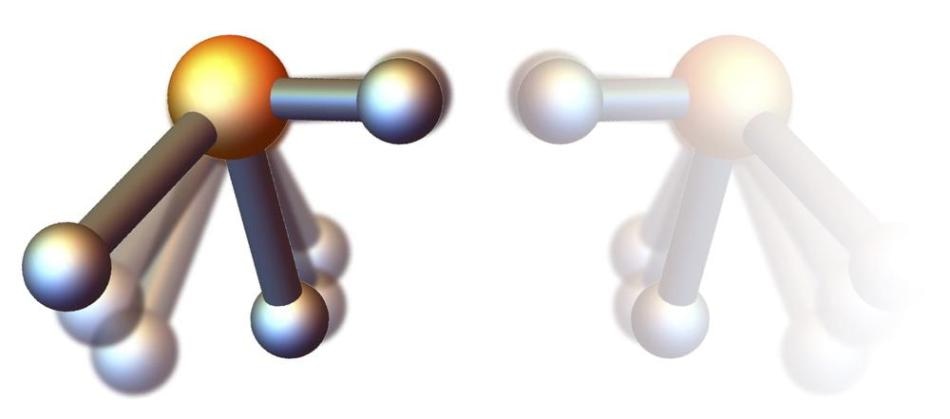Nov 12 2018
Investigating the mystery of nature’s molecular handedness, researchers have proposed a novel experimental technique to produce customized mirror molecules for research purposes.
 Due to the rapid rotation, the phosphine molecule loses its symmetry: The bond between phosphorus and hydrogen along the axis of rotation is shorter than the other two such bonds. Depending on the direction of rotation, two mirror-inverted versions of the molecule are formed. (Image credit: DESY, Andrey Yachmenev)
Due to the rapid rotation, the phosphine molecule loses its symmetry: The bond between phosphorus and hydrogen along the axis of rotation is shorter than the other two such bonds. Depending on the direction of rotation, two mirror-inverted versions of the molecule are formed. (Image credit: DESY, Andrey Yachmenev)
Through this method, normal molecules will rotate so fast that they would lose their normal shape and symmetry, forming mirrored versions of one another. The latest approach has been described in the journal Physical Review Letters by the researchers from DESY, University College London, and Universität Hamburg headed by group leader Jochen Küpper.
The additional analysis of chirality (derived from the ancient Greek word for hand, “cheir”), or handedness, not only provides a better understanding of the workings of nature, but it can also lead to the development of innovative methods and materials.
Similar to human hands, a number of natural molecules exist in two versions that are mirror images of one another.
“For unknown reasons, life as we know it on Earth almost exclusively prefers left-handed proteins, while the genome is organised as the famous right-handed double helix,” stated Andrey Yachmenev, who heads this hypothetical work in Küpper’s group at the Center for Free-Electron Laser Science (CFEL). “For more than a century, researchers are unravelling the secrets of this handedness in nature, which does not only affect the living world: mirror versions of certain molecules alter chemical reactions and change the behaviour of materials.”
For example, the right-handed version of carvone (C10H14O) imparts a distinctive taste to caraway, whereas the left-handed version is an important factor for the spearmint taste.
Chirality, or handedness, occurs naturally only in certain types of molecules.
However, it can be artificially induced in so-called symmetric-top molecules. If these molecules are stirred fast enough, they lose their symmetry and form two mirror forms, depending on their sense of rotation. So far, very little is known about this phenomenon of rotationally-induced chirality, because hardly any schemes for its generation exist that can be followed experimentally.
Alec Owens, Study Co-Author, the Hamburg Center for Ultrafast Imaging
Now, to realize this rotationally-induced chirality with genuine parameters in the laboratory, Küpper’s team has computationally developed a method that employs corkscrew-shaped laser pulses called optical centrifuges. For the phosphine (PH3) example, the teams’ quantum-mechanical calculations demonstrate that the phosphorus-hydrogen bond, rotated by the molecule at rotation rates of trillions of times per second, becomes shorter when compared to the other two of these bonds, and based on the sense of rotation, two chiral forms of phosphine form.
“Using a strong static electric field, the left-handed or right-handed version of the spinning phosphine can be selected,” Yachmenev explains. “To still achieve the ultra-fast unidirectional rotation, the corkscrew-laser needs to be fine-tuned, but to realistic parameters.”
This method offers the potential for an entirely different path via the looking-glass into the mirror realm because, in principle, it would also work with other types of heavier molecules. These would, in fact, need weaker electric fields and laser pulses, but were rather too complicated to be resolved in these initial stages of the analysis. Yet, since phosphine is known to be highly toxic, such heavier as well as slower molecules might be required for experiments.
Küpper believes that the recommended technique might offer customized mirror molecules, and the study of these molecules’ interactions with the environment, for example, with polarized light, will help to further explore the secrets of handedness in nature and investigate its potential application.
Facilitating a deeper understanding of the phenomenon of handedness this way could also contribute to the development of chirality-based tailor-made molecules and materials, novel states of matter, and the potential utilization of rotationally-induced chirality in novel metamaterials or optical devices.
Jochen Küpper, Professor of Physics and Chemistry, Universität Hamburg